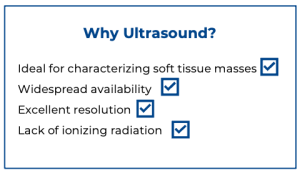Introduction
Neck mass is a common presenting complaint in the pediatric population with a broad differential diagnosis. Point of care ultrasound (PoCUS) provides a rapid, non-invasive, and real-time evaluation of these masses. Indications for bedside ultrasound assessment include palpable neck masses, cervical lymphadenopathy, and evaluation of suspected neck infections or malignancies.
Common causes of neck swelling in children include enlarged lymph nodes, most often due to inflammatory or reactive responses, infections, or – less commonly – malignancies. Congenital developmental masses, benign neoplastic lesions, and salivary gland infections also contribute to the range of potential causes. Malignancies can also be a cause of neck swelling and are important to consider in the differential diagnosis although rare.
In the evaluation of a neck mass, a comprehensive approach is essential. This involves gathering a detailed medical history, conducting a thorough physical examination, and investigations including laboratory work and imaging studies when clinically indicated (1). Cervical lymphadenopathy ranks among the most common contributors to neck swelling in children. This module will specifically concentrate on the assessment of the diverse causes of lymph node swelling using PoCUS.
Why Ultrasound?
Ultrasound (US) is considered the primary imaging modality of choice for evaluating inflammatory neck masses because of its widespread availability, excellent resolution, and lack of ionizing radiation (2,3). Ultrasonography can define the size, shape, and characteristics of the mass and any associated vascularity. Ultrasonography can also define the tissues surrounding the mass, providing more clues to the etiology. Further, US is safe, cost-effective, and available in real time. It is also readily available in most hospital settings.

PoCUS imaging of neck masses compares favourably to formal radiological assessments. One study assessed PoCUS with radiology department ultrasonography (RaDUS), while another compared PoCUS with multiple radiological evaluations (RaDUS, CT, or both). Both studies involved pediatric patients aged 0 to 18 years presenting with neck swelling to the emergency department. POCUS trained pediatric emergency physicians concurred with radiology-based imaging diagnoses in 77% -78% of cases in two studies with. Corresponding kappa values were also comparable—0.69 (95% CI 0.44–0.94) and 0.71 (95% CI 0.60-0.83) respectively (4,5).
These studies not only highlight the diagnostic accuracy of PoCUS but also shed light on its ability to identify a wide range of neck pathologies. The spectrum of diagnoses includes, but is not limited to, lymph node abnormalities (infections, inflammation, and malignancies), solid tumors, congenital cysts, parotitis, and others. These findings support PoCUS as a reliable, rapid, and non-invasive diagnostic tool in the pediatric emergency setting, offering a valuable complement to history, physical exam, and other imaging modalities.
In addition, performing PoCUS was found to reduce emergency department length of stay i in children presenting with neck masses (5,6).
